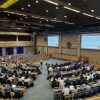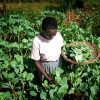Tuesday, May 14, 2024
News and Views from the Global South
RIGHTS: Fewer Conflicts, But More Refugees
Tarjei Kidd Olsen
- Despite a reduction in the number of violent conflicts around the world, the number of internal refugees has soared to levels not seen since the end of the cold war.
According to another report by NRC, released in June, there were another 16 million refugees that had to escape to countries other than their own, an increase of about 600,000 on the previous year.
The increase in internal refugees – known as internally displaced persons (IDPs) in development circles – and refugees comes despite a reduction in wars and other serious conflicts from 35 to 31 in the past two years.
According to NRC's head of information and advocacy Rolf A. Vestvik, this seeming contradiction was caused both by an increase in the number of displacements and a reduction in the number of people returning home.
"It's a complicated picture, but an important reason is that conflicts are becoming more brutal as warring parties increasingly seek to deliberately displace people as a part of their strategies, while violence and other methods of repression are becoming ever harsher. So even if the numbers of conflicts have decreased, their intensity and the degree of persecution have increased," Vestvik said.
Almost half of all IDPs were in Africa, as were almost half the number of new IDPs due chiefly to conflict in Somalia, Sudan and the Democratic Republic of Congo. The Middle East saw the largest relative increase mainly because of Iraq, where 700,000 people fled last year's violence. Sudan had the world's largest number of IDPs (5.8 million), and accounted for more than half of all IDPs together with Colombia (4 million) and Iraq (2.5 million).
IDPs tend to be in a much more difficult situation than border-crossing refugees, according to Vestvik. Part of the reason is that they have less legal protection.
"A refugee that crosses a border is then automatically protected by the 1951 UN refugee convention, a legally binding international document. This gives refugees a series of rights such as education, protection, and so on. IDPs, on the other hand, have no formal rights and no international conventions, and so they are a lot less protected," Vestvik said.
IDPs are protected by a non-binding set of guidelines known as the Guiding Principles on Internal Displacement. While not perfect, Vestvik says that NRC would actually prefer not to attempt to incorporate IDP rights into the refugee convention for the moment as negotiations could result in a weaker convention than the one negotiated in 1951.
"Even if the Guiding Principles aren't as strong an international document as the refugee convention, they have played an important role. It is possible that we will change our mind in the future and decide to renegotiate the convention, but at the moment we prefer to use the Guiding Principles tactically in order to convince as many states as possible to honour their duties," Vestvik said.
The fact that conflicts are becoming more brutal also works against IDPs.
"It is increasingly often difficult to even gain access to IDPs. A good example is Afghanistan, which has a total of 160,000 IDPs, many tens of thousands of which are located in areas which we can't or are not allowed to visit due to the security situation. It's the same in Somalia, in parts of Sri Lanka, and other countries," Vestvik noted.
Worryingly most new IDPs had to flee from their own governments, as was the case in 21 of the 28 countries with new displacements, although rebel groups were also a cause in 18 of the countries.
"One example is Sudan, where the Khartoum regime is responsible for at least some of the IDPs we see in Darfur. There are many similar situations, where governments either displace people deliberately or prevent humanitarian organisations from operating," said Vestvik.
In addition there are many 'forgotten' conflicts that receive little attention from the wider world.
"The reality is that while a few conflicts get a lot of attention, there are a lot of other conflicts that are not part of the international agenda and which therefore do not attract the donor funds for aid work that organisations such as ours are dependent on. The conflict in Central African Republic (CAR) is a good example," Vestvik said.

 Print
Print




